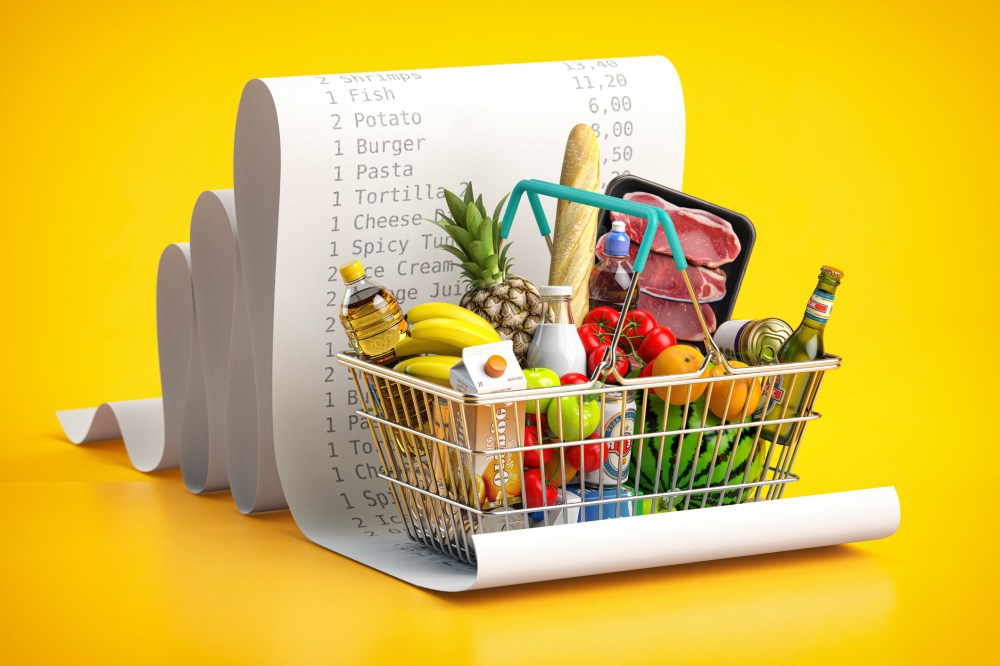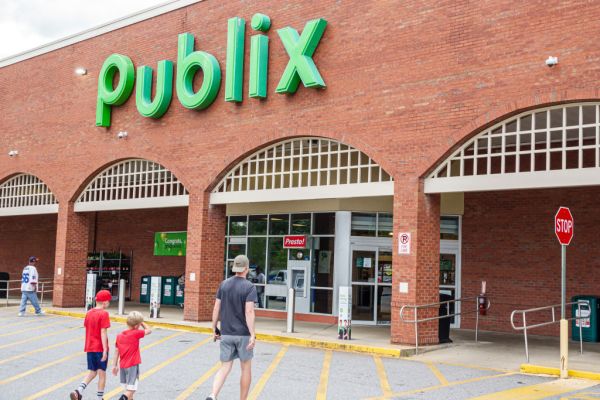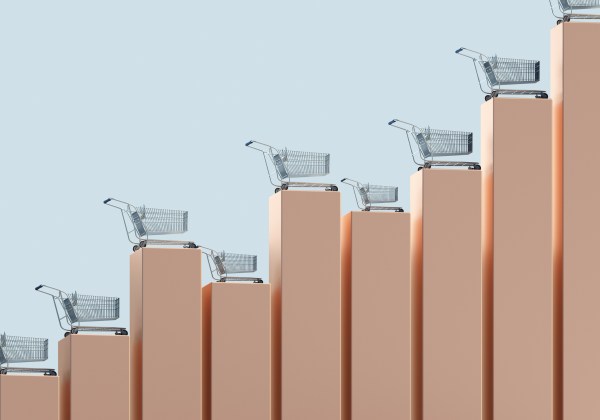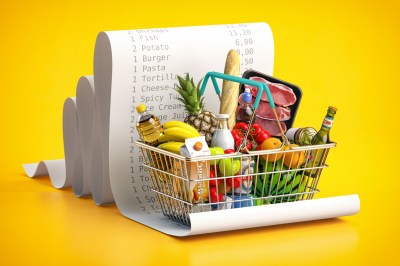If you think, as Kamala Harris thinks, or says she thinks—(“thinks”)—that inflation in grocery prices is the result of “price gouging,” then I don’t want to hear you ever complaining about conspiracy theories. Because that is a big, dumb conspiracy theory, the sort of thing that can be taken seriously only by asses of exceptional asininity.
Here’s a question: Why doesn’t a Big Mac cost $500? Why doesn’t a pack of socks at Walmart cost $500? “Well, nobody would pay that!” comes the usual answer. Au contraire mon frère! People will pay $500 for a hamburger—and some people will pay $5,000 for a hamburger. And $500 for a six-pack of socks? Pantherella does a brisk business in socks at that price point. “Oh, but those are super-high-end luxury goods!” you may retort. Of course—and in most of the world, for most of human history, paying somebody else to cook you a meal was a 1-percenter luxury good, too. But the luxury goods are interesting for the same reason the bargain-basement goods are interesting: because in a robust marketplace, you have lots of buyers and lots of sellers, and lots of products at lots of price points. So you can buy your tailored silk socks for $80 a pair or buy 300 on Amazon for 22 cents a pair. There are a lot of car buyers and car sellers in the United States, and a lot of good options at different price points.
The food market is, as you might expect, a big one: There are a lot of different places to buy groceries in the United States, from big corporate behemoths such as Walmart and Amazon (which owns Whole Foods Markets) to the major national chains such as Kroger (which is, among other things, the largest sushi seller in the country, as well as the owner of Southern California’s beloved Ralphs, no apostrophe), to more regional concerns such as Meijer (“Meijer’s” if you are from Michigan) or Piggly Wiggly (which is a real thing in the South!). There are also locally owned independent shops, and insufferably twee people such as the Williamsons may sometimes get up on a Saturday morning and go down to the local farmer’s market and buy bacon from a guy who was personally acquainted with the pig. Behind those consumer-facing retail outlets is a large and complex network of distributors—national and regional—warehouses, trucking and logistics operations, and, upstream of them, producers ranging from domestic farmers and ranchers to Israelis who sell us olive oil to Mexican lettuce farmers and Thai fruit-juice producers. We grow more than $700 million worth of tomatoes in the United States and import another $2.5 billion worth. We import seafood from India, potatoes from Canada, and meat from Australia (and New Zealand, and Mexico, and Italy, Canada, and Chile—we love the stuff). Millions upon millions of people and firms, billions of transactions, scores of countries—and, somehow, Kamala Harris imagines a shadowy figure behind it all, pulling the strings.
Retailers’ pricing power is one of the most misunderstood factors in economics in the United States. When Congress proposes some new tax or costly regulation, you can bet you will hear some barstool tut-tutting about how sellers “will only pass the cost on to consumers.” Sometimes that is true, and sometimes it isn’t. Companies such as Walmart and McDonald’s have very price-sensitive customers. Grocery-store customers in general are pretty price sensitive: A large majority of American shoppers—80 percent or so—report frequently or occasionally putting items back on the shelf at the grocery store because of an unexpected price increase. There is a lot of money to be made at the lower end of the market, which means Walmart and McDonald’s have a lot of competition. If McDonald’s just jacks up prices willy-nilly, Burger King is right next door, along with Wendy’s, Chick fil-A, etc. (The battle for fast-food consumers is epic.) The guys at Walmart are pretty smart, and one of the things they know is that Target exists, that Amazon exists, and that Aldi exists. And if they forget that, their customers remind them—good and hard. That’s one reason profit margins are historically so low in grocery stores.
Why do prices go up? There are different answers for different kinds of markets.
The market for certain kinds of luxury goods, certain positional goods (meaning goods that are consumed for status-enhancing reasons), certain Veblen goods (meaning a subset of positional goods for which demand counterintuitively increases as the price goes up) have changed a great deal in the past few decades for macroeconomic—and macro-socioeconomic—reasons unrelated to the goods per se. You might have noticed, for example, that prices for really good seats at a big-name concert or Broadway show have increased shockingly, even if the cheap seats haven’t changed all that much, or that certain brands now put out limited-edition products at prices that seem entirely out of step with the usual expectations associated with those brands—and that in many cases, the manufacturer’s suggested retail price (MSRP) is only a fraction of the price on the secondary market, which is where real prices emerge for many of these artificially scarce goods. If you happen to score a coveted pair of limited-release sneakers or a particularly desirable model of luxury watch, you often can double or treble your money—or make even more—by turning around and selling that product. A basic Rolex Submariner is notionally $9,100 from an authorized dealer, but, if you actually want to get one without waiting for years, then you pay the real price, on the secondary market, which is more like $15,000. Taylor Swift tickets aren’t easy to come by, and the best seats are going for as much as $15,000.
These absurd prices come from the combination of two factors. The first is that many of these goods are truly limited in their production—Swift is playing only so many shows, and there are only so many front-row seats; Rolex, which is owned by a charity, is not under the kind of profit-margin pressure that a normal company would be, and though it is a high-volume maker by the standards of Swiss luxury horology, it’s only going to make what it is going to make. The second factor is that there are a lot more very rich people in the world than there used to be, and a whole lot more pretty-rich people than there used to be. In the 1990s, the number of people in India, China, and many other countries who were rich by rich-world standards was pretty small. In 1996, there were no Indians among the world’s richest 150 people, no Chinese (Hong Kong was still notionally independent in that year), only a handful of Saudis, etc., with most of the world’s super-rich living in the United States, Western Europe, Japan, or Canada. In 1996, India’s middle class was probably 100 million to 125 million people; today, it is more like 440 million and likely on its way to 1 billion by the middle of this century, and it is a richer middle class than it was in the 1990s. India’s middle class, like those of many similar countries, is also young: 65 percent of middle-class Indians are under 35. They are young, mobile, and have money to spend.
People are used to thinking of businesses as competitors and thinking of producers and sellers as competitors, but it is at least equally true that consumers are competitors—not only in their roles as workers and producers but in their role as consumers per se. We don’t just compete for high-paying jobs; once we have those high-paying jobs, we compete with socioeconomically similar people for scarce goods—especially positional goods, genuinely limited goods, and status-conferring goods. (If you want to begin to understand life in the capitalist world in the 21st century, begin with the fact that once people have obtained a surprisingly modest level of material comfort, their attention shifts away from competing primarily for material resources and toward competing for status.) In 1996, a well-off American was competing for the best concert tickets with other well-off Americans, mainly. Even in the case of tourist destinations such as Las Vegas, visitors were competing for the best hotel suites mainly with other similarly situated Americans. Today, those same Americans are competing with the grandkids of Indonesian billionaires and young Indian executives and Brazilian bankers you’ve never heard of but who have serious money. And even among the lower-level affluent—the well-off but not ridiculously rich—a once-every-few-years splurge on a vacation or a show is much more within reach than it was a generation ago.
The case of luxury goods is a reminder that there is always room at the top of the market. When James Bond bought his Rolex Submariner in the 1950s, he would have paid the equivalent of less than $2,000 in 2024 dollars, not the $9,100 you’d pay for one today if you could find a Rolex shop that will sell you one or the $15,000 you’d pay on the secondary market. Until very recently in human history, those $2 million watches from Richard Mille had no real equivalent. It is worth keeping in mind that high prices do not necessarily mean high margins or large profits. Tom Ford tuxedos still cost $6,000, but the brand still makes most of its money from higher-volume, lower-priced items such as perfume and accessories. And the best way to get seriously rich isn’t always selling more expensive stuff: The guys who sell Big Macs make a heck of a lot more money than the guys who run Per Se or Eleven Madison Park and similar restaurants with $1,000-a-head tasting menus. But McDonald’s can’t raise prices 500 percent in a couple of years simply because there is a booming economy in Singapore or Kuwait producing a surplus of rich people willing to spend the price of a used Honda on dinner for four.
Prices at the grocery store have gone up for a few reasons. One is that prices, like wages, can be “sticky,” and COVID-era bottlenecks and supply-chain disruptions caused a price spike that did not subside entirely—or at all, in some cases. Another factor is that important inputs have become more expensive: Fast-food restaurants typically spend more money on labor than they do on food (something to think about the next time you’re at the drive-thru), and, though I don’t have numbers for grocery stores, it is safe to assume that the same is roughly true of grocery stores. In fact, for Americans’ overall food expenditures, labor is the single largest cost, accounting for almost 50 cents on the dollar, as the USDA runs the numbers. (Farmers take in less than 15 cents on the food dollar.) Wages for grocery-industry workers climbed significantly during the pandemic and continue to climb—and are likely to continue doing so as long as trends such as a relatively low workforce participation rate keep it relatively hard to find workers. That’s great for workers, but even if the “pass it along to consumers” story is an oversimplification, it is going to put upward pressure on prices.
And then there is good old-fashioned supply and demand. You may have heard of something called the “quantity theory of money,” which is, in effect, a fancy way of saying that the laws of supply and demand apply to money just as they would to any other good. Flood the economy with a lot of money, as Congress has been doing for years with the aid of both the Trump and Biden administrations, and you’ll end up with money that is worth less than it would have been if there were less of it in circulation. (Yes, it’s a little more complicated than that, especially if you want to account for the effort to keep prices nominally stable, but that’s basically it.)
And this brings us back to Harris: Like any populist worth the name, the Democratic presidential nominee is promising to keep flooding the economy with lots more money, proposing, among other things, gigantic subsidies for homebuyers and covert welfare payments through the tax code—some $1.7 trillion in new handouts, as the New York Post runs the numbers. Democrats are also all over the Fed trying to get it to cut rates, hoping that will reduce the interest rates charged on mortgages and car loans. So: Give would-be homeowners $25,000 in assistance and lower mortgage rates to drive down their monthly payments, and what do you think is going to happen to housing prices? They are going to go … up. They are going to go up for the same reason grocery prices have: more money chasing a constrained supply of goods.
Harris’ team has talked about tax subsidies and other incentives for developers who build lower-income homes and rental properties, but the problem there isn’t a lack of incentives—the problem is that Harris’ buddies in San Francisco and other similar places make it damn near impossible to build houses, so the only houses that get built are relatively expensive ones. There are some progressives who have got the message about the need for zoning reform, and it isn’t only progressives who have hindered development—there is NIMBY-ism on the right, too—but, so far, there hasn’t been a lot of real progress on that front, and progress on that front probably is going to have to come mainly from Democrats: There are a gajillion unoccupied housing units in this country, but they are mostly in places where nobody wants to live. Even in Republican-leaning states such as Texas, it is the cities that are the real engine of economic growth, and the metropolitan areas are where the desirable jobs are—and where the housing shortages are, too.
Harris’ economics are, as economics, just wildly illiterate—straight-up buffoonery. And that is why she needs a conspiracy theory, which is what you should call the imbecilic notion that there is a shadowy cabal of avocado bosses robbing the American middle class.
And Furthermore …
So, what’s a little pander? A lot, potentially.
Harris is plainly a say-anything-at-any-time kind of politician, one without any real beliefs or non-negotiable principles. At least, that is the impression she is giving right now. I’m no fan of the base-stealing opportunists who call themselves “pragmatists” and pretend that they are beyond ideology, interested only in “what works,” but I will say a good word for genuine pragmatism, which is oriented toward coalition-building and the cultivation of consensus, a political attitude rooted in the important knowledge—so often ignored in our contemporary politics—that the other side exists, that it has some power and is going to have some power, that these facts have to be taken into account if you want to build a stable, long-term policy environment that reflects, however imperfectly and incompletely, your philosophy and preferences. As Jonah Goldberg has often observed, one of the most destructive and unproductive ideas in our current politics is the naïve belief that total victory is possible for either side.
Genuine pragmatism of the sort I have in mind is the political attitude that says: “We need to make an expansive free-trade deal with the European Union, which is going to be unpopular with some Democratic constituencies and some Republican constituencies, but there are things we can do to soften that opposition and reduce the disruption to U.S. business interests that will face costs from new competition.” Or: “We need an expansive education-reform package, which will be opposed by some Democratic constituencies and by more Republican constituencies than you might think (Republicans are a disproportionately rural party, and public-school systems are major employers in many rural communities, often the largest single employer), but we can sweeten the deal with this or that payoff, introduce the most painful reforms gradually, etc.”
But Harris isn’t that kind of pragmatist. She’s a demagogue. She is part of an administration that has made inflation worse by fighting for and securing excessive spending, mainly on parochial partisan interests, and, in order to dodge responsibility for that and shift the blame to a politically expedient target, is pretending that the problem is greedy businessmen who need to be regulated by central planners in Washington. She probably doesn’t mean it and, if elected, probably won’t try very hard to pursue price controls or have very much success if she does—probably. But moving politics in that direction—a direction that combines centralization and executive aggrandizement with cynical scapegoating—is inherently dangerous, and not only for economic reasons. It is politically and morally dangerous as well.
Another way of thinking about this is that Harris’ all-over-the-map politics comes from weakness rather than from strength. Powerful, self-assured presidents—Ronald Reagan, Barack Obama, Franklin Roosevelt—can and do work out compromises all the time. They aren’t idiots, and they understand that there is give-and-take in a democratic system.
That isn’t what Harris is up to—at all. She is—the inevitable and unfortunate truth—a lot like Donald Trump, belonging to a school of politicians (Ted Cruz is one, Elizabeth Warren is another) who call to mind the cynically earnest pickup artist in David Foster Wallace’s Infinite Jest, who approaches women and says: “Tell me what sort of man you prefer, and then I’ll affect the demeanor of that man.” For that kind of weak politician, nothing is off the table.
Trump, of course, is the exemplary reminder that you cannot trust a weak person with power. Weak politicians are dangerous—in many cases, much more dangerous than the stronger kind. Government is a big mean dog, and norms are the leash that keeps it from going Cujo on all of us at any given moment. Weak men and weak women, who do not have principles to limit them or strong characters to fortify them, can’t keep the dog on the leash—they just let it run. And a candidate who will tell you that bananas are expensive because evil men are plotting against you is weak—politically weak, morally weak, intellectually weak. The U.S. government arguably is the most powerful human entity in the history of our species, and it is very often dominated by spiritual and/or mental weaklings: Joe Biden, Donald Trump, Bill Clinton, Richard Nixon, Newt Gingrich—hell, Andrew Johnson, if you want to keep digging.
Words About Words
There’s only one? Surely not. From the New York Times:
Ms. Craig, the Minnesota Democrat who is openly gay, said Republicans would have a hard time pigeonholing her governor or making the liberal label stick. She recalled that during her first term in Congress, Mr. Walz took her hunting for wild turkey. She could shoot—trap shooting is a big sport in the state—but she had never hunted turkey.
Watch your commas, New York Times! Or your articles. You could write: “Minnesota Democrat Angie Craig, who is openly gay …” Or you could write: “Ms. Craig, a Minnesota Democrat who is openly gay.” The Times is having some trouble because it is mentioning Ms. Craig down in the article a ways from where she was first mentioned, so the writers feel the need to remind readers who she is. Commas can act like parentheses: “Ms. Craig (who is openly gay) is a Minnesota Democrat …” There is a difference between “The drummer, who has a drug problem, is someone you don’t want in your band, for lots of reasons” and “We were trying to choose from among the three of them and decided that the drummer who has a drug problem is someone you don’t want in your band.”
Completely unrelated question: What does her being gay have to do with turkey hunting? If there is some special kind of lesbian turkey-hunting technique that the ladies have been keeping secret all these years, I want to know about it.
Elsewhere …
You can buy my most recent book, Big White Ghetto, here.
You can buy my other books here.
You can see my New York Post columns here.
Please subscribe to The Dispatch if you haven’t.
You can check out “How the World Works,” a series of interviews on work I’m doing for the Competitive Enterprise Institute, here.
In Conclusion
I wrote a pretty rough review of a dumb book on Sunday. But worse than dumb, it was dishonest. People who write about politics and public affairs should try not to be dumb, but they should try even harder not to be dishonest. And if I may be parochial, Christians writing Christian-themed books should try very hard not to bear false witness. It’s important.







Please note that we at The Dispatch hold ourselves, our work, and our commenters to a higher standard than other places on the internet. We welcome comments that foster genuine debate or discussion—including comments critical of us or our work—but responses that include ad hominem attacks on fellow Dispatch members or are intended to stoke fear and anger may be moderated.
With your membership, you only have the ability to comment on The Morning Dispatch articles. Consider upgrading to join the conversation everywhere.